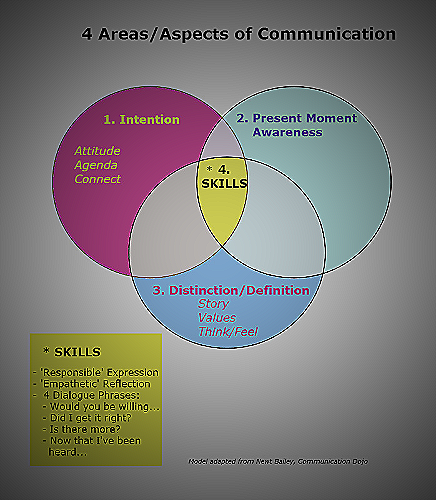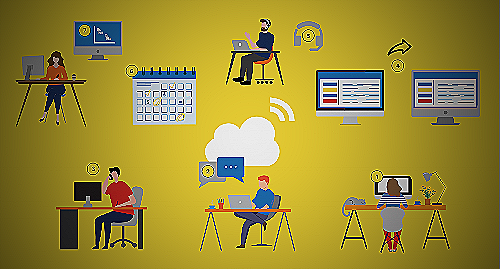23 Areas for Improvement in Remote Work
Remote work has become more common in recent years, especially because of the pandemic. While remote work offers many advantages such as better work-life balance and increased productivity, there are still areas for improvement that need to be addressed.
Recognizing these areas and finding ways to improve them is crucial for ensuring that remote work remains effective and efficient.
Looking to improve your skills and knowledge in the workplace? Check out this Youtube video showing how to identify your strengths and areas for improvement.
Don’t miss the opportunity to learn valuable tips and insights that can help you grow and advance in your career!
1. Communication
When it comes to identifying areas for improvement in remote work, communication is one of the crucial factors to consider. Clear and effective communication is essential, especially when teams work in different time zones and have limited face-to-face interactions.
Here are some strategies to improve communication in remote teams:
- Establishing clear communication procedures
- Regularly scheduled meetings
- Effective use of communication tools
Remote teams need to have a well-established process for exchanging information. This includes how to share updates, where to store files, and how to communicate feedback.
This avoids confusion and ensures that everyone is on the same page.
Meetings help remote teams to stay aligned and updated on projects. Scheduling regular meetings and sticking to a routine can help establish a sense of normalcy and keep everyone motivated.
Remote workers rely on communication tools like email, messaging apps, video conferencing software, and project management systems. Choosing the right tools and ensuring everyone knows how to use them can significantly improve communication.
Some common communication challenges include language barriers, technical issues, and conflicting time zones. Remote teams can address these challenges by ensuring that the communication process is transparent and that everyone is included in the conversation.
Managers should be available to answer any questions and help resolve any issues that arise.

2. Productivity
Remote work is not without its productivity challenges, but there are several areas for improvement that can help remote employees increase their productivity and achieve their goals. These areas for improvement include:
- Effective time management techniques: Remote employees need to be able to manage their time effectively to ensure that they are meeting their deadlines and achieving their objectives. This can include utilizing time-blocking techniques, setting priorities, and minimizing distractions.
- Tools that can increase productivity: There are several tools available that can help remote employees be more productive, such as time-tracking apps, collaboration tools, and project management software. By utilizing these tools, remote employees can increase their efficiency and stay on top of their work.
- Strategies for maintaining focus during the workday: Many remote employees struggle with staying focused because they work from home, where there are numerous distractions. To combat this, remote workers can create a dedicated workspace, establish a structured routine, and take regular breaks to recharge their minds.
By paying attention to these areas for improvement, remote employees can enhance their productivity and achieve their goals more effectively.

3. Areas for Improvement: Work-Life Balance
While remote work offers the flexibility and convenience of working from the comfort of your own home, it can also blur the lines between work and personal life. This is why creating a work-life balance is crucial when working remotely.
Below are some tips to help you achieve a better balance:
- Set clear boundaries: Establish clear start and end times for work, and communicate this with your team and family. This helps differentiate between work and personal time.
- Create a schedule: Plan out your work and personal tasks for the day/week. Make sure to prioritize self-care activities such as exercise, hobbies, and spending time with loved ones.
- Designate a workspace: Set up a dedicated work area that is separate from your personal space. This creates a physical boundary between work and home life.
- Disconnect: Disconnect from work during your personal time. Avoid checking work emails or taking work calls during non-work hours. This allows for a mental break and helps reduce stress levels.
By implementing the tips above, you can improve your work-life balance and create a more fulfilling remote work experience.

4. Accountability
One of the areas for improvement when working remotely is accountability. It can be difficult to stay motivated and productive when there is no direct supervision, and distractions abound.
Here are some strategies for increasing accountability:
- Set clear goals and track progress: Create specific, measurable, achievable, relevant, and time-bound (SMART) goals. Use project management tools like Trello or Asana to keep track of your progress towards these goals. Share your progress and accomplishments with your team for increased transparency.
- Hold oneself and others accountable: Take ownership of your responsibilities and hold yourself accountable for meeting deadlines. Set reminders and schedule regular check-ins to hold others accountable as well.
- Provide constructive feedback: Feedback is essential for creating a culture of accountability. Recognize and praise achievements, but also provide feedback for improvement. Use a growth mindset by focusing on opportunities for growth and improvement rather than mistakes.

5. Collaboration
Remote work has opened up new ways for collaboration and teamwork. However, remote collaboration comes with its own set of challenges that need to be addressed.
- The importance of team building: While it may not be possible to hold in-person team building events, there are still ways to build a sense of community among remote team members. Regular video calls that include informal conversations, team-building games, and activities can help create a connected, collaborative remote team.
- Ways to establish trust and mutual respect among team members: Remote teams need to establish trust and respect among team members, which is essential for effective collaboration. This can be done by encouraging open communication, setting clear expectations, and showing gratitude for work well done.
- Strategies for effective teamwork and collaboration: Remote teams need to establish sustainable workflows that ensure everyone is aligned and knows what is expected of them. Regular video meetings and real-time chat tools can help team members stay connected and communicate effectively. Using project management tools such as Trello or Asana can help teams stay organized and focused on their goals.
Areas for Improvement in Remote Work: Technology
One of the biggest benefits of remote work is the ability to use technology to work efficiently and effectively from anywhere. However, there are still areas for improvement in the use of technology in remote work.
- Essential tools for remote workers: The right tools are essential for remote teams to work effectively. This includes collaboration and communication tools like video conferencing, instant messaging, and project management software.
- Ways to stay up-to-date with new technologies: Technology is constantly changing, so it’s important for remote workers to stay informed about new tools and software that can improve productivity and efficiency. This can be achieved through online courses and webinars, as well as staying connected with other remote workers and industry professionals.
- Setting up a reliable home office for remote work: A reliable home office is essential for remote work. This includes a high-quality internet connection, a comfortable and ergonomic workspace, and the right equipment like a reliable laptop, headphone, and microphone to support remote communication and collaboration.
Overall, by staying up-to-date with the latest technology trends, remote workers can be just as productive, if not more so, than their in-office counterparts. The key is to have the right tools, stay informed, and create a reliable home office environment.

7. Professional Development
As remote work becomes more popular, it is essential for workers to continue professional development to stay relevant and competitive in their job market. Here are some ways to continue professional development in a remote work environment:
- Seek out online courses and certifications: One of the most significant benefits of working remotely is the flexibility it offers. Remote workers can use their free time to learn new skills and pursue advanced certifications, which can be completed online. This will help them maintain a competitive edge in the job market.
- Attend virtual conferences and webinars: Many conferences and professional events are being moved online because of the pandemic. This means that remote workers can attend these events without having to travel. Virtual conferences and webinars offer valuable opportunities to connect with other professionals, learn new skills, and stay up-to-date with industry trends.
- Join online professional communities: Social media platforms like LinkedIn, Slack, and Twitter offer opportunities to connect with other professionals and industry leaders. Joining online professional communities can help remote workers create relationships, exchange ideas, and access job opportunities.

8. Workload Management
Managing one’s workload while working from home is a challenge that many remote workers face. Working from a home environment presents more opportunities for distractions and disruptions compared to a typical office setup, making it difficult for remote workers to concentrate on their tasks.
To manage one’s workload effectively, remote workers need to develop effective strategies for prioritizing tasks. One way to do this is to create a to-do list of tasks that need to be completed in a day and prioritize them based on their level of urgency.
It’s important to ensure that the most important tasks are done first thing in the morning when energy levels are higher.
Another way to manage distractions and interruptions is to communicate with family members or roommates about the importance of uninterrupted work time. Designing a home office space that separates work from leisure can be helpful.
This can be achieved by having a separate room or area dedicated solely for work. Additionally, one can schedule regular breaks and time off to recharge and improve work-life balance.

Overall, managing one’s workload as a remote worker is essential in staying productive and achieving professional goals. By implementing the strategies discussed above, remote workers can tackle their tasks efficiently, minimize distractions, and maintain a healthy work-life balance.
9. Mental Health and Wellness
Maintaining good mental health while working remotely is imperative to increase productivity and for overall well-being.
- The challenges of remote work on mental healthRemote work can result in anxiety, stress, and a feeling of isolation due to limited interaction with colleagues. Long working hours, staying seated in front of the screen, reduced physical activity, blurred lines between work and home life can lead to exhaustion as well.
- Tips for maintaining good mental healthTo maintain good mental health while working remotely, it is essential to take regular breaks to move around and stretch, establish boundaries between work and personal life, and engage in work-life balance activities like hobbies, sports, or volunteer work.
- Effective ways to manage stress and anxietyEffective ways to manage stress and anxiety include good sleep habits, developing a support system, staying connected with family and friends, practicing mindfulness techniques, exercising regularly, and seeking professional help if necessary.

10. Self-Motivation
Self-motivation is crucial when working remotely to ensure that productivity levels remain high. When working remotely, it can be easy to become demotivated and struggle to find the motivation to complete tasks.
Here are some effective strategies for staying motivated while working remotely:
- Set yourself achievable goals to work towards, both in the short-term and long-term. These goals should be specific, measurable, and realistic.
- Break down larger goals into smaller, more manageable tasks. This can make these goals less overwhelming and more achievable.
- Create a sense of purpose in your work by understanding and connecting with the reasons why you are doing what you’re doing. This can provide the motivation needed to tackle difficult tasks.
- Establish a routine to help structure your day, which can help boost productivity and motivation. Your routine should include regular breaks, exercise, and a set start and end time to your workday.
- Surround yourself with positive reinforcement, whether that is through talking to colleagues or friends, finding a mentor, or posting motivational quotes around your workspace.
By implementing these strategies, remote workers can stay motivated and productive while working independently.

11. Onboarding and Training
Effective onboarding and training programs are critical to the success of remote employees. However, remote onboarding and training present unique challenges.
Challenges of Remote Onboarding and Training
Remote onboarding and training require a different approach than in-person onboarding and training, as employees are not physically present in the office and may feel isolated or disconnected from their new team. Employers must find a way to set clear expectations, ensure that new hires feel welcome and connected to their team, and provide the necessary training and resources to be successful without face-to-face interaction.
Effective Strategies for Remote Onboarding
- Create a welcoming and comprehensive onboarding plan and schedule
- Provide clear instructions and a detailed introduction to company culture, goals, and values
- Assign a remote onboarding and training buddy to new hires
- Set up virtual team-building activities and introduce new hires to existing team members
Training Options for Remote Employees
When it comes to training, employers may opt for a variety of remote solutions. Some options include e-learning courses, on-the-job training, virtual workshops, one-on-one coaching sessions, and webinars.
Employers must choose a training method that aligns with their employees’ learning styles and goals.
The Role of Feedback and Evaluation in Onboarding and Training
Feedback and evaluation are critical components of any onboarding and training program. Clear communication regarding expectations and progress can help remote employees feel supported and engaged.
Employers should provide regular feedback and evaluations, both during and after the training period, to ensure that employees have the necessary resources to succeed in their new roles.
Team Management in the Age of Remote Work
Remote work is on the rise, and with it comes the need for effective team management strategies. Managing a remote team presents unique challenges that traditional office settings don’t face, such as communication barriers and the lack of face-to-face interaction.
To ensure that your remote team is working effectively and efficiently, here are some areas for improvement to consider:
1. Clear Expectations
Setting clear expectations for team members is essential when working remotely. With the lack of physical presence, it’s easy for miscommunication to occur.
To avoid misunderstandings, it’s vital to establish and maintain clear expectations from the outset, including project deadlines, communication channels, and work hours.
2. Performance Evaluation
Monitoring team performance in a remote work environment is challenging, but it’s necessary to ensure that everyone is working towards the same goals. To evaluate team performance, establish key performance indicators (KPIs) that are measurable and specific.
Regularly communicate these KPIs to your team, and provide feedback based on their results.
3. Feedback and Evaluation
Feedback and evaluation are essential components of team management, and it becomes more crucial when managing remote teams. Providing constructive feedback motivates employees to improve their performance.
Encourage team members to share feedback and suggestions with each other, which leads to a stronger team as everybody works towards common goals.
Areas for Improvement: Maintaining Professionalism in Remote Work
Remote work has provided many professionals with the opportunity to enjoy a flexible work-life balance. However, it also comes with challenges that require individuals to maintain professionalism while working from home.
Below are some areas for improvement to help remote workers stay professional:
- Effective communication and etiquette for remote workers: Communicating through text, email, or instant messaging requires remote workers to be clear, concise, and professional. They should also consider time zone differences when scheduling meetings or sending messages.
- Ways to maintain a professional image while working remotely: Remote workers should dress appropriately for work, even if they are working from home. They should also consider their background during video calls and have a designated workspace to differentiate their work and personal life.
- Setting expectations for professionalism with remote team members: Employers should establish guidelines to ensure remote team members maintain a professional image, adhere to company policies, and understand their responsibilities. Employers should also provide training on remote work etiquette and communication.

14. Technological Literacy
Remote work requires a higher level of technological literacy in order to maintain communication and productivity away from the office. Here are some ways remote workers can improve their technological skills:
- Essential technological skills for remote workers: Remote workers need to be comfortable using various forms of technology, such as video conferencing software, project management tools, and cloud-based storage systems. In addition, they should have a good understanding of basic troubleshooting techniques in case of technical issues.
- Ways to stay up-to-date with new technologies: Technology is constantly evolving, so it is important for remote workers to stay up-to-date with new software and tools that can help improve productivity. They can read industry publications and attend webinars or online courses to learn more.
- Training options for improving technological literacy: Employers can provide remote workers with training programs to improve their technological literacy, such as online courses or in-person workshops. This can help ensure that all remote workers are comfortable using the necessary tools and software to perform their jobs effectively.

Conclusion
Remote work offers several advantages, including flexible working hours, better work-life balance, and increased productivity. However, remote workers face challenges such as distractions, difficulty collaborating, and poor time management.
To overcome these challenges, remote teams should establish clear communication, delegate tasks and track progress, maintain regular check-ins, build awareness, provide access to tech, and encourage daily routines and movement breaks. Remote work requires careful planning and implementation to optimize its benefits and minimize its drawbacks.
By addressing the areas for improvement, remote teams can achieve success and enhance their work experience.

